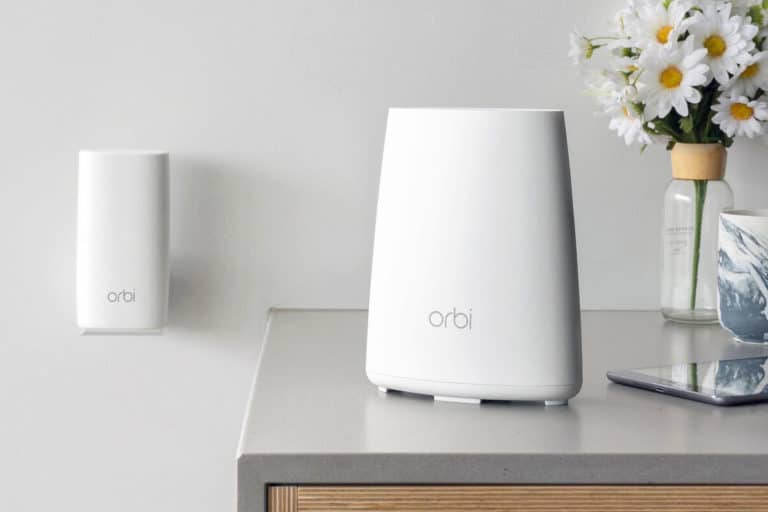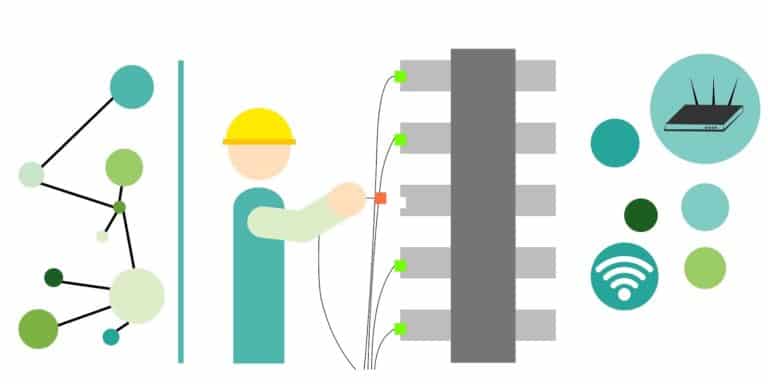TP-Link AX6000 vs AX11000: Which is Really Worth the Hype?
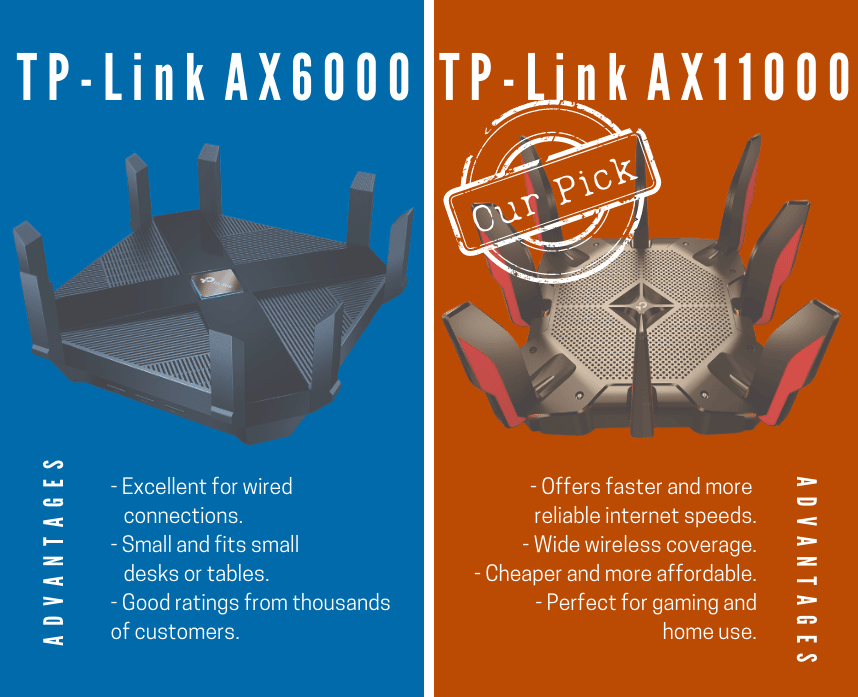
With recent technological advancements, more smart devices mean more bandwidth use. You need a strong router to handle them all at once. So let’s compare TP-Link AX6000 vs AX11000 to see which Wi-Fi 6 router is best for multiple devices.
We’ve tried and reviewed different routers, and we understand that getting a router upgrade can be difficult. So to make things easier, we’ll look at the performance, speed, coverage, design, cost, and ratings.
Generally, the Archer AX6000 is an efficient Wi-Fi 6 router that focuses on comfortability and convenience. As for the AX11000, it’s an excellent option for gaming and large homes with huge user demand.
Both routers are strong, efficient wireless routers. But let’s see which best suits your home, office, and gaming needs.
Table of Contents
TP-Link AX6000 vs AX11000: In a nutshell
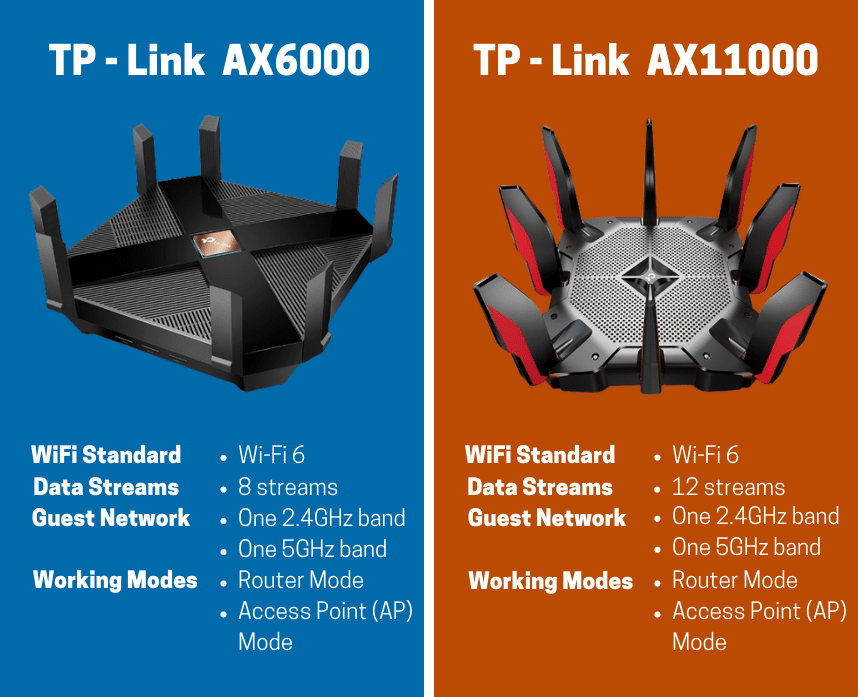
The TP-Link Archer AX6000 is an 8-stream, dual-band router. Multiple wireless devices can enjoy optimum internet speeds with MU-MIMO, OFDMA, 4T4R, and 8 data streams.
The Archer AX6000 supports up to 5.9 Gbps of speeds. With 8 undetachable antennas, it can provide wireless signals to a large home with 4 bedrooms. It’s a good all-around router that can be used for smart home devices and gaming.
The TP-Link Archer AX11000 is a 12-stream, tri-band router. It also supports MU-MIMO, OFDMA, and 4T4R. The 12 data streams leave more “lanes” for devices so everyone can enjoy optimum speeds.
Although it’s also an excellent home router, the Archer AX11000 is best for gaming purposes.
The game accelerator and game protector boost gaming performance. Plus, you can keep your gaming experiences safe and relatively fast. You can also use one of the 5GHz bands specifically for gaming and get up to 4.8Gbps speeds.
The Archer AX6000 and Archer AX11000 are both Wi-Fi 6 routers. With Wi-Fi 6, each router has 4 times higher capacity and efficiency. Both routers are protected with HomeCare and are also OneMesh ready!
With that, browsing the internet is safer and more secure. Plus expanding your network with mesh routers is easier and more efficient.
TP-Link AX6000 vs AX11000: Performance
The AX6000 and AX11000 are both high-performing routers. With an impressive list of specifications, let’s see which is better.
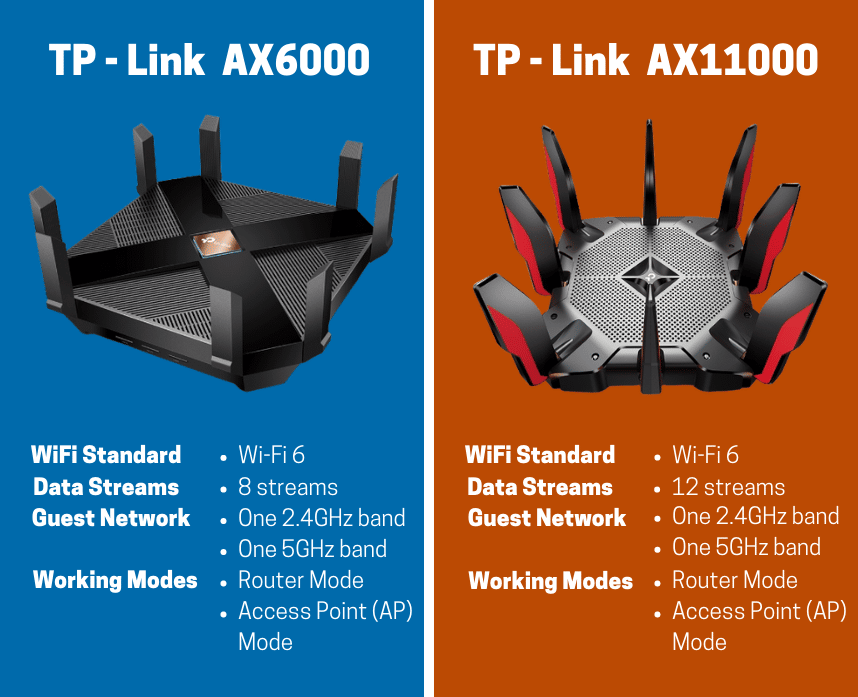
| Specifications List | TP-Link AX6000 | TP-Link AX11000 |
| WiFi Standard | Wi-Fi 6 | Wi-Fi 6 |
| Data Streams | 8 streams | 12 streams |
| Guest Network | One 2.4GHz band One 5GHz band | One 2.4GHz band One 5GHz band |
| Working Modes | Router Mode Access Point (AP) Mode | Router Mode Access Point (AP) Mode |
Looking at the specifications list, the AX6000 and AX11000 have a lot in common. Both are Wi-Fi 6 routers, which provide a better and faster Wi-Fi experience.
Compared to Wi-Fi 5 and Wi-Fi 4 routers, they can keep up with multiple connected devices at once. They can distribute optimum speeds to mobile devices more efficiently. So whether you’re gaming or need a router for video streaming, you’ll be just fine.
The Archer AX11000 does have one advantage: 12 data streams. Yes, data streams matter!
Ideally, the more data streams, the better. Multiple devices can have internet access simultaneously, so bandwidth shortage won’t be a problem.
Think of data streams as paying for groceries. If 12 counters are open instead of 4 or 8, all transactions are super smooth and fast. You don’t need minutes to wait in line. Plus, if there’s a shorter line at one of the counters, you can just go there!
Winner: TP-Link Archer AX11000
Hardware Specs
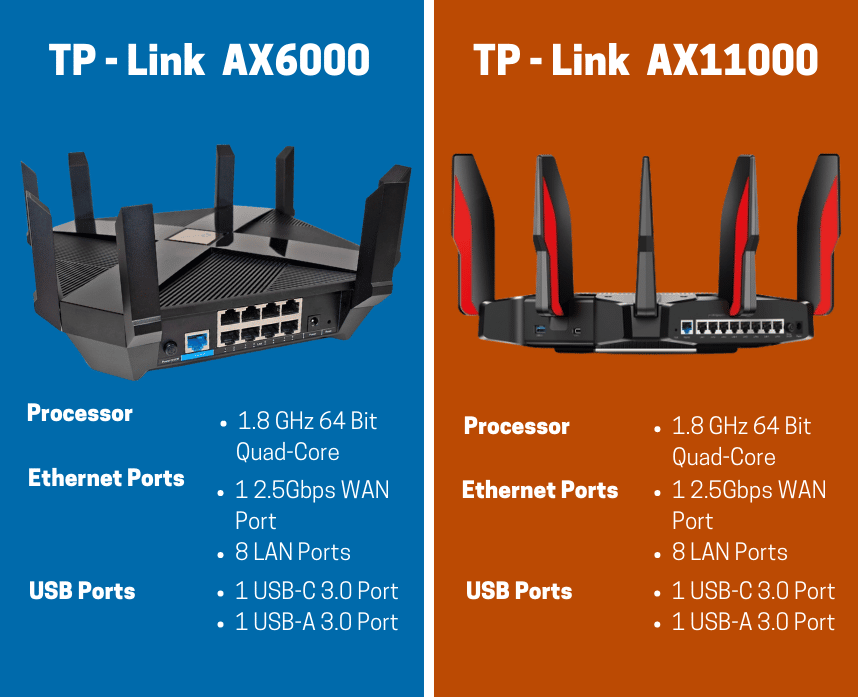
| Specifications List | TP-Link AX6000 | TP-Link AX11000 |
| Processor | 1.8 GHz 64 Bit Quad-Core | 1.8 GHz 64 Bit Quad-Core |
| Ethernet Ports | 1 2.5Gbps WAN Port 8 LAN Ports | 1 2.5Gbps WAN Port 8 LAN Ports |
| USB Ports | 1 USB-C 3.0 Port 1 USB-A 3.0 Port | 1 USB-C 3.0 Port 1 USB-A 3.0 Port |
| Power Button | ✔ | ✔ |
| Wi-Fi Button | ✔ | ✔ |
| LED Button | ✔ | ✔ |
| WPS Button | ✔ | ✔ |
| Reset Button | ✔ | ✔ |
The Archer AX6000 and AX11000 are both great for expanding wired connections. Both have the same number of ethernet ports and the same USB ports.
The 2.5 gigabit WAN port allows a faster transfer rate. The 8 LAN ports are excellent for connecting wired devices like game consoles, PCs, smart TVs, or other wired routers.
Although processor-wise, the AX11000 stands out from the AX6000. Both routers have 1.1.8 GHz Quad-Core processors. But the AX11000 has 3 additional co-processors while the AX6000 has 2.
A more powerful processor lets your router perform its best all the time. With AX11000 having 3 co-processors, it has more capacity to perform heavy-duty tasks.
Winner: TP-Link Archer AX11000
TP-Link AX6000 vs AX11000: Wi-Fi Speed and Coverage
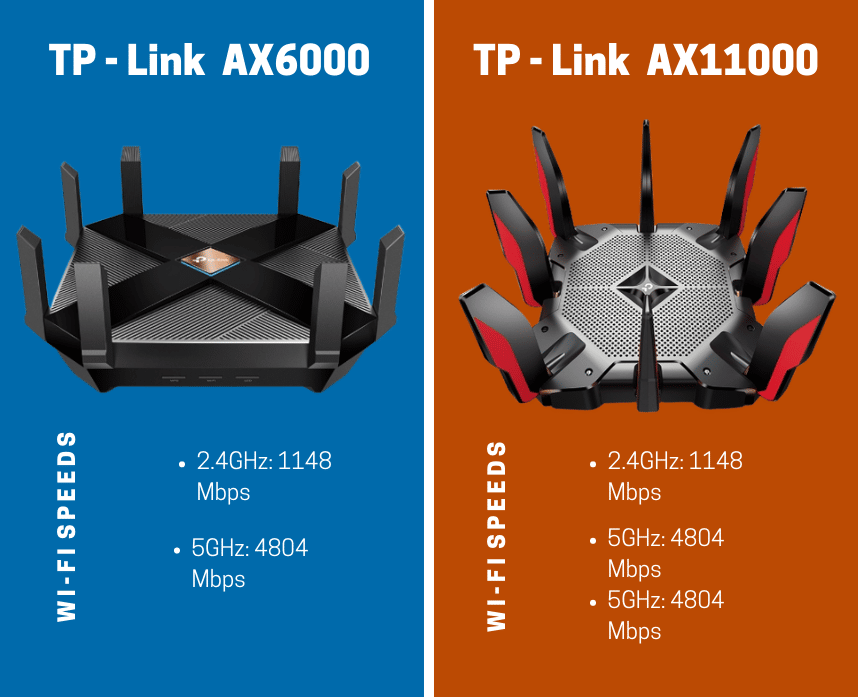
Living in a smart home is everybody’s dream. But with more smart devices, you need a fast wi-fi router with wide wireless coverage. Of course, you need one with a strong wireless signal wherever you are in the house, right?
Let’s see which between the TP-Link AX6000 vs AX11000 is better.
Wi-Fi Speed and Coverage
| Specs | TP-Link AX6000 | TP-Link AX11000 |
| Wi-Fi Speeds | 2.4GHz: 1148 Mbps 5GHz: 4804 Mbps | 2.4GHz: 1148 Mbps 5GHz: 4804 Mbps 5GHz: 4804 Mbps |
| Beamforming | ✔ | ✔ |
| MU-MIMO | ✔ | ✔ |
| OFDMA | ✔ | ✔ |
| Airtime Fairness | ✔ | ✔ |
| DFS | ✔ | ✔ |
| High-power FEM | ✔ | ✔ |
| 4T4R | ✔ | ✔ |
| Antennas | 8 high-powered antennas | 8 high-powered antennas |
The TP-Link Archer AX11000 is a tri-band router with one 2.4 GHz band and two 5GHz bands. Both of the 5GHz bands offer 4.8 Gbps of speeds, so the AX11000 is relatively faster.
Although the AX6000 offers fast internet speeds too. With the help of band-steering, it moves your devices to a less-congested band.
It supports up to 1.1Gbps on the 2.4 Ghz band and 4.8Gbps on the 5GHz band. The AX6000 is competitive enough for gaming and regular home use.
Aside from the Wi-Fi speeds, AX6000 and AX11000 have the same built-in technologies. Both have very high wi-fi capacities and are excellent for big homes.
4X4 MU-MIMO, OFDMA, Airtime Fairness, and 4T4R increase the router’s capacity to handle multiple connected devices simultaneously.
Additionally, beamforming, high-power FEM, and 8 antennas boost wi-fi signals throughout the home.
The detachable antennas give the AX11000 a slight advantage. With detachable antennas, you can easily point it in different directions for better, wider signals.
In this case, the AX11000 can cover 4-6 bedroom houses. As for the AX6000, it can provide signals to 4-bedroom houses.
Winner: TP-Link Archer AX11000
TP-Link AX6000 vs AX11000: Features and Design
| Features and Design | TP-Link AX6000 | TP-Link AX11000 |
| TP-Link HomeCare | ✔ | ✔ |
| OneMesh Compatibility | ✔ | ✔ |
| Size and Dimensions (WxDxH) | 10.3 × 10.3 × 2.4 in. | 11.3 × 11.3 × 7.2 in |
| Ease of Use (Easy set up on the Tether App or TP-Link website) | ✔ | ✔ |
The Archer AX11000 is built and designed for gaming. With the black and red color combo, you’ll love putting this in your game room. It’s a bit bulkier and bigger which can be a bit hard to hide.
The Archer AX6000 is smaller and has a more minimalistic vibe. The router’s black body makes it easy to hide and style in offices or living rooms.
Both Archer AX6000 and Archer AX11000 come with a lifetime subscription to TP-Link HomeCare. HomeCare protects your home network and comes with:
- Parental control
- Built-in antivirus
- Quality of service (QoS)
- Malicious site blocker
- Intrusion Prevention System (IPS)
Additionally, both routers are compatible with Alexa and OneMesh. So creating a smart home and mesh ecosystem is easier and more convenient.
Setting up and customizing these features are easy on the Tether App. You’ll have all access to HomeCare and see the reports from day 1 of installation.
Winner: Tied
TP-Link AX6000 vs AX11000: Cost and Customer Ratings
Both the Archer AX6000 and AX11000 are on the expensive side of the spectrum. Although it’s a bit pricey, the features and specs really make up for it.
Most customers loved how fast both routers are and how convenient it is to set up. Although some complained about compatibility, it’s somehow inevitable.
Cost Winner: TP-Link Archer AX11000
Ratings Winner: TP-Link Archer AX6000
Our Verdict: TP-Link Archer AX11000
In our comparison between TP-Link AX6000 vs AX11100, the TP-Link Archer AX11000 wins with a slight advantage. It’s perfect for gaming and big homes with multiple devices. With 12 data streams, all connected devices can enjoy optimum, blazing speeds.
If you have a big home with a huge demand of users, we can say that the AX11000 is a better choice. But depending on your preference, the best router is the one that best suits you.
If you want to see how the TP-Link AX6000 compares to the AX3000, we’ve got that article for you!

